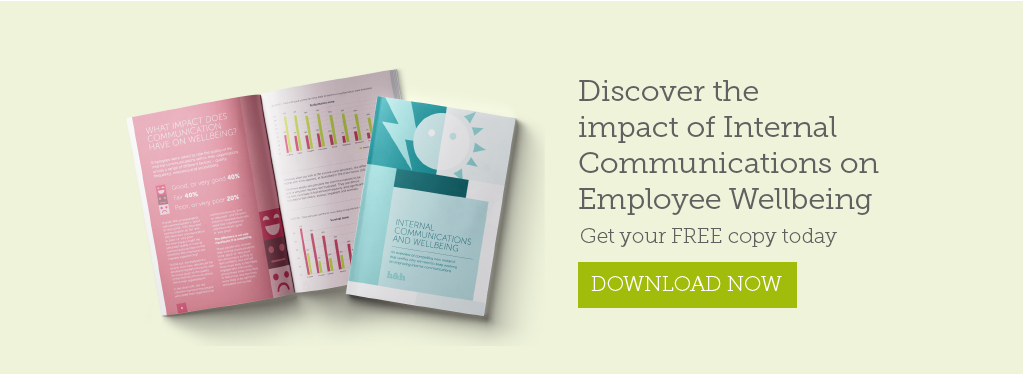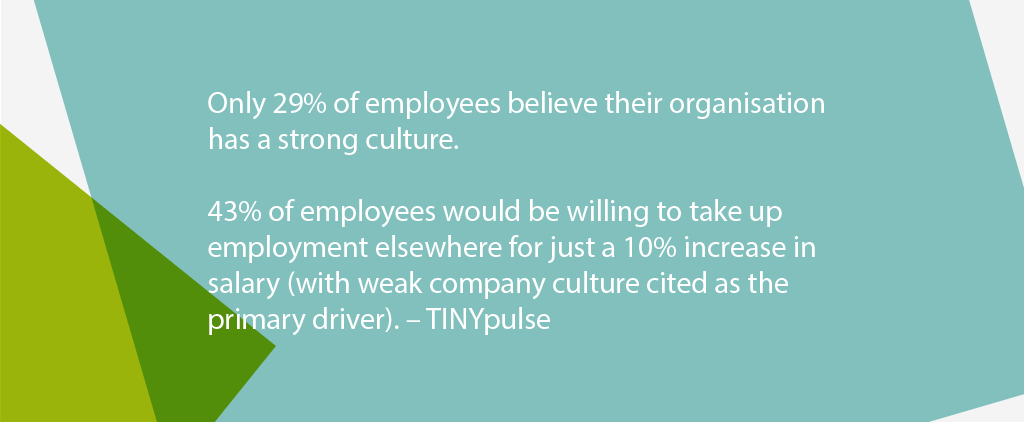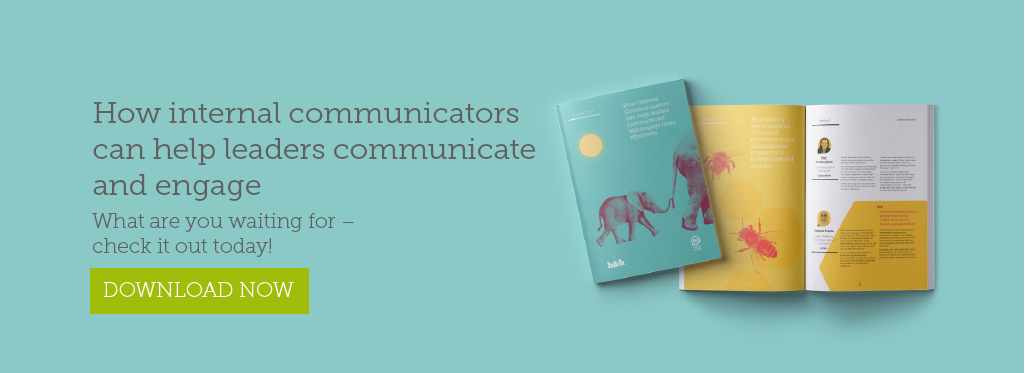Keeping up with internal communications trends can be tough.
By the time you’ve supported a new change initiative, cascaded the new three year plan, and built an engagement programme for the front lines to open up two-way dialogue – you probably find yourself so caught up in day-to-day that you struggle to even glimpse at the emerging trends changing the face of the industry at large.
If this sounds like you; don’t panic. You’re far from being alone. Planning ahead and considering critical internal communications trends and challenges is a skill that a lot of internal communications professionals have struggled to get on top of.
But just like driving in the dark with your headlights on dip – focusing only on the industry practices right in front of you can stop you from seeing important trends hovering on the horizon.
Meaning you miss vital opportunities to maximise the impact of your internal communications.
While we might not have an all-knowing crystal ball to help us predict the future of what IC might look like, we do have access to a vast reservoir of resources, research studies and reports to help us understand which internal communications trends and challenges may have a major influence on how we communicate with people in our organisations.
Just imagine what you could achieve if you had all this strategically priceless information to hand right now…
Well, you don’t need to imagine. Because we’ve pored over every internal comms resource, report and whitepaper from the last 12 months to identify the 7 most critical internal comms trends you may find yourself coming up against over the year ahead.
And we’ve noted them all down in this handy guide – designed to support you in achieving the best outcomes from your IC strategies and campaigns in 2020.

7 internal communications trends and challenges to watch out for in 2020
Trend 1: Thinking beyond the employee experience to employee wellbeing
Thankfully, it’s no longer widely considered acceptable to wear stress like a badge of honour at work.
And you’ll no doubt be acutely aware of the recent shift in focus to the wider employee experience – where an employee’s every interaction with the organisation comes under the engagement spotlight.
But there’s still so much more we can do to fundamentally revolutionise the physical and emotional experience for employees.
And it involves thinking beyond the employee experience, to hone in on employee wellbeing.
Not just on the ‘soft’ things like Beer Fridays, team gym sessions or beanbags. But on the emotions that people are genuinely feeling when tackling the cut and thrust of their day-to-day roles.
Have you ever heard someone ask – what will be the impact on the health of our people if we increase our revenue target by 5%?
We bet, probably not. But as an internal communications or engagement professional, you’re in a uniquely privileged position to make a significant impact on the health and happiness of your organisation’s people.
We all know that effective internal communication plays a major role in boosting employee engagement as well as a number of other performance factors.
But the extent of IC’s impact on employee wellbeing and engagement wasn’t empirically revealed until very recently.
Our own research – we believe the first of its kind – confirmed that employees who experience good internal communications are far more likely to regularly feel emotions associated with the ‘Performance zone’ – where we’re confident, optimistic, energetic and enthusiastic.
Conversely – those who experience poor internal communications frequently find themselves in the Survival or Burnout zones. Battling emotions such as frustration, anxiety, exhaustion and depression.
We don’t have to tell you which is more conducive to organisational success!
So what can we do to get ahead of this internal communications trend?
First, download the full report to bring yourself up to speed on the connection between internal comms and employee wellbeing.

Then, use this indisputable information to make the case for raising the profile of IC within your organisation. We’re talking HR Directors, People Managers, and the folks in your C-Suite. Put some time aside to bolster awareness of the value that good internal communications brings to the wellbeing (and therefore performance) of your people.
And if you haven’t already – consider altering your internal communications strategy to put people’s wellbeing front and centre to maximise their time in the Performance zone.
Trend 2: Making the complex, simple
We all understand the importance of not bombarding our colleagues with reams and reams of heavy-handed, complex messages.
Wading through the quagmire of chaotic information and elevating the most important messages to the surface is a key comms skill we can deploy intuitively as second nature.
But does the COO know to spare employees the masses of complicated and cryptic numbers in the latest performance brief?
Or does the CEO know to keep their monthly check-in blog as short and simple as possible so that people actually have time to digest it on the go?
Making the complex, simple might come naturally to us communications pros, because it’s what effective communication is all about. And we do it every day.
But for most of our colleagues, their main concern isn’t how to best get their messages across. They just want to get the information out there – by whatever means necessary.
And in a world where employees are frequently time-poor and don’t have much capacity to devote to keeping up with communications – this scatter-gun strategy simply won’t achieve the cut-through needed to inspire action and make messages stick.
Sadly, it’s an all too common approach. So much so, that excessive volumes of communication – and a lack of time for employees to connect with it – bagged the top spot as the number-one barrier to success for the second time running the latest State of the Sector report.
Suggesting there’s still plenty we can do to connect with and coach our colleagues to communicate more effectively.
So what can we do to overcome this internal communications challenge?
If we’re lucky, colleagues reach out to us for advice and support on how to go about it and make the messages resonate with their audience. But you’ve probably felt the frustration of being roped in to ‘wave your magical comms wand’ and conjure something up at the eleventh hour.
To really make a difference, we need to use our privileged position as comms experts to drive real meaningful action around strategic communication in our organisations.

We need to rub shoulders with those who most frequently cascade comms downstream to employees on the ground. Don’t leave IC training to the L&D team. Get proactive about teaching the benefits of focused and effective IC across the business.
It might push us a little out of our comfort zones. But staying safe and doing things the way we’ve always done them is hardly a palatable recipe for creating a shift.
Which leads us nicely onto…
Trend 3: Be more strategic
IC professionals can get so tied up in communicating the vision, values and strategies of the organisation. It’s easy to forget to spare time for our own communication strategies.
But developing, monitoring and adapting internal communication strategies is vital to ensuring long-term success and engagement.
Without a wider strategy to tie your tactical comms activity together, you’re essentially batting blind in the dark. And chances are, you’re swinging and missing more often than you land a hit.
In the words of Sun Tzu:
Tactics without strategy is the noise before defeat.
We might enjoy short bursts of disjointed success through targeted tactical activity. But we’ll miss out on the substantial long-term opportunities for achievement. The ones that come with devising and delivering a considered, well-thought-through and grounded strategic approach to communications planning.
Of course, we know this. Understanding and communicating organisational strategies makes up a hefty chunk of IC professionals’ day-to-day remits.
So why do we so often neglect to shine the spotlight on our own strategic activities?
It’s not that we’re not doing it at all. But ‘developing and refreshing an internal communications strategy’ places far below other priorities within IC functions.
Only 33% of us have a written IC strategy that goes beyond the next 12 months.
And what about detailed strategic audience profiles? Well, just 17% of internal communicators admit to having these fleshed out.
With so many challenges to grapple with like economic uncertainty, increased competition, complexity of technology adoption and the challenge of attracting and retaining the best talent– we think it’s vital to consciously devote the time needed to revisit IC and engagement strategies and consider whether they’re genuinely fit for purpose.
Today, most of our clients value us as a long-term agency partner to help them set strategic direction, provide tactical support and support them to implement, monitor and measure their IC activity.
So what can we do to get ahead of this internal communication trend?
Learn to say no (or at least, ‘not yet’). When we’re being pulled in so many divergent directions and asked to pull content out of the hat at the drop of a – well, hat – we know it can be hard to see the word for the trees.
But we need to take advantage of IC’s profile as a more widely respected business function to drive a more strategic approach to internal communications activity.
Take some time out of your busy schedule to prioritise the most important activities and balance strategy with tactical delivery.
Are you writing someone’s email announcement, or are you helping them to target the right people with the right messages by offering a key messaging narrative and supportive advice?
It might rub a few colleagues the wrong way when you stop doing their comms for them, but this will empower your people and free up time for you to focus on more value-adding activities over the long term.
If you’re struggling to turn away less valuable workload, ask yourself: what’s the ultimate goal that your internal communications function is acting in service of? You can use this answer as the conversation starter with colleagues you may feel you’re ‘letting down.’
By proactively becoming more strategic in your support of organisational messages and the delivery of content to employees – you’ll help to further drive the value of IC in your organisation.
Ultimately, it’s a win-win situation! And isn’t that an opportunity we should be grasping hold of with both hands?
Trend 4: Work with leaders to build irresistible organisational cultures
An organisation’s culture can make or break their success.
And because culture significantly influences how people behave and work, it plays a major role in motivating them to go above and beyond to achieve results.
A great culture can enthuse and inspire people to make a difference to the organisation in any way they can.
Whereas a demoralising culture can leave them going through the motions, spluttering along in first gear – or drive people away overnight.
Unfortunately, it seems a lot of organisations are suffering from the latter.
Let’s look at the numbers:

And around the same number are ‘always open to new job offers’ or are planning a career move imminently.
That means just under half of your colleagues could be ready to hand their notices in at any moment.
Scary thought, right?
We’ve always believed that cultures should be shaped around and by the people who live them every day.
But even when a prescribed culture is cascaded down from senior management, we have a significant role to play in articulating and galvanising employees to demonstrate the right behaviours, attitudes and actions around it.
And just as organisations have to find a unique angle to differentiate themselves for their customers – they also have to find a novel approach to differentiating themselves for their employees.
Not to mention prospective candidates, who are now much more discerning about the companies they choose to join.
So what can we do to get ahead of this internal communications trend?
You’ve no doubt heard it before, but it’s important to wrangle your way closer to senior leaders to share your expertise on the employee experience. To help them find the spark of uniqueness in your Employee Value Proposition that sets the organisation apart.
If you’re familiar with Dan Pink’s theory of autonomy, mastery and purpose, you’ll know that when we’re directly engaged in creating something with purpose, we’re much more likely to be motivated and inspired by it.
We need to fight in our colleagues’ corner – ensuring senior leaders understand the value in getting them involved in shaping the culture.
We can also take advantage of our wordsmithery skills too, by chunking up the desired values, behaviours and attitudes into a top-level culture code. This creates a snapshot blueprint to guide employees on what’s expected of them in their day-to-day that they can refer back to at any time.
To give you a clear idea of what a culture code looks like, take a look at our culture video:
Trend 5: Get to grips with measuring results
Do you have a robust system in place for monitoring and reporting on the impact of your internal communications activity?
Measuring results is absolutely critical to understanding what we’re doing right and what we could do better. As well as identifying how our efforts are impacting the bottom line.
But we’re still seeing a worryingly low number of IC professionals who have actually mastered measurement in their organisations.
And perhaps even more alarmingly…

It begs the question – how can we expect to definitively prove IC’s credibility and value in the business, if we can’t back up our claims with irrefutable evidence and facts?
Measuring an intangible concept like employee engagement can be a tough gig. And it can be tempting to focus on the more accessible metrics like open and click rates, intranet page visits and other basic outputs.
But these measurements don’t actually tell us how our activities have contributed to better performance in the business.
To really get to the nub of internal communication’s impact, we need to focus on the things that matter. And that means honing in on whether we’ve helped employees to do their jobs better and contribute more effectively to their organisation’s success.
So what can we do to get ahead of this internal communications ‘trend’ (because it’s not really going to go away)?
It’s important to focus on more sophisticated measurements.
We need to think beyond downloads, bounce rates, and employee engagement surveys (which only tell you how people are feeling at one specific time, and ignore many potential other engagement factors).
Instead, we need to examine the shift in behaviours, actions and mindsets that have been achieved because of our internal communications.
Has there been an increase in performance in the right areas after solid efforts to communicate the strategy and vision?
Has there been a noticeable upswing in people demonstrating the best ways of working?
And finally – is this driving better overall business results?
Measuring self-contained campaigns with specific goals is a little easier, as you can wrap-up the insights from measurements at the close of the project.
But don’t be too shy to own the contribution that an effective IC and engagement programme makes to business results. For ongoing strategic projects, it helps to check-in on progress more frequently to get an idea as to whether shift is happening as anticipated.
Trend 6: Crack the line manager communication conundrum
You’ll likely know that line managers have proved a consistent problem for internal communications professionals.
Not because line managers are ineffective as a comms channel. In fact, the proximity and authority they have to their teams puts them in a prime position to drive engagement with the front lines.
No, line management communication is a problem because they’re often not adequately equipped to communicate effectively.

Have you ever worked hard to cascade some critical communications down from the C-Suite – only to see them being bogged down in the ‘frozen middle’ because line managers lack the skills and capabilities to communicate effectively with their people?
Well, this trend unfortunately looks set to continue into the new decade.
‘Poor line manager communication skills’ ranked as the second-biggest barrier to success last year.
And yet, just 20% of internal comms professionals say they’re prioritising the improvement of line manager communications in 2020.
If we’re going to tackle one of our biggest challenges to IC success, we need to put more effort and resource into resolving it.
So what can we do to get ahead of this internal communications trend?
The key to getting more value out of the IC function this year is to proactively spend more time equipping line managers with the tools and training they need to be more effective communicators.
There’s lots of value that can come from sharing our knowledge and insights with this audience – who function as a critical bridge between the C-Suite and the front line.
When we neglect to focus on this particular audience, we raise this bridge up – severing the cross-organisational connections we’re working so hard to create.
So don’t hoard your knowledge. Share it.
Organise workshops with line managers to boost their confidence and capabilities.
Create supporting comms materials to help managers hold better conversations with their teams around key messages.
Coach them on how to listen to their teams as much as share information with them.
And work with them to uncover their unique personal strengths, so that you can build on these to support the most effective delivery of internal communications.
Remember – line managers are not only a communications channel in themselves, but also an important audience segment to tailor your comms and engagement activities towards.

Trend 7: Filter out fake news (and stop it from spreading around your organisation)
Remember a few years ago when fake news wasn’t even a thing?
We do too. But now it’s infecting social media feeds, poisoning mindsets and potentially even deciding elections.
It’s not a new phenomenon though.
To a certain degree, internal communications teams have always grappled with the challenges of preventing the spread of misinformation inside organisations.
“Senior managers haven’t released the most recent figures – we must really be tanking this quarter.”
“We haven’t heard much about this proposed merger – it must not be going very well.”
But here’s the rub. The explosion of instant communication tools like social networks and online forums have made it much easier for disinformation to catch on and swiftly spread out of control.
So we’re sure you won’t be surprised to see ‘tackling fake news’ listed as a key internal communications challenge for 2020.
But as it turns out, the driving force for fake news control and prevention has its roots in the C-Suite.
Over half of communicators say stopping fake news is a top priority for senior leaders over the years ahead.
It’s easy to see why. Once the poisonous Pandora’s box of misinformation has been opened, it can be hugely difficult to get under control.
This is especially problematic if internal rumours make it into the outside world. This doesn’t just harm employee morale – it can jeopardise your brand too.
So what can we do to overcome this internal communications challenge?
The easiest way to stop the spread of fake news in your organisation is to put the fire out before it starts.
Often, gaps in communication is what gets the office grapevine growing.

Get this – 93% of employees say they would rather hear bad news than be left in the dark.
As internal communications professionals, our role is to create clarity for everyone across the business – whether they’re based at HQ, on the shop floor, or spend the majority of their time on the road.
We’re at ground zero when it comes to ensuring employees have all the information they need to do their jobs well.
So we’re in a powerful position to prevent rumours and misinformation from taking hold by ensuring we provide a constant stream of insightful, relevant and universally accessible content.
So consider your internal comms activity and channels, and think about whether there are any gaps in the information being shared.
Do you use your comms network to gather feedback and check how top-down messages are being interpreted?
Are you keeping your ears open at the water cooler to hear what news and stories are trending amongst colleagues on the ground?
Take advantage of your view from the trenches to identify the information needs of different employee audiences.
And again (spot the theme): it comes down to strengthening our relationship with senior leaders. So we can understand acutely what they want to say, as well as championing what employees want and need to hear.
Clearly, there’s lots we can be doing over the months and years ahead to surmount these key trends and challenges.
But we have immense confidence that we can achieve it.
Because if there’s one thing we’re all exceptional at– it’s overcoming adversity when the odds are stacked against us.
Besides, after making it this far, you should now be gifted with helpful insights and guidance on how you can plan ahead and prepare for these internal communications trends.
To summarise, our 7 internal communications trends are:
- Think beyond the employee experience to focus on employee wellbeing.
- Prioritise making the complex, simple.
- Be more strategic.
- Work with leaders to build irresistible organisational cultures.
- Get to grips with measuring results.
- Crack the line manager communication conundrum.
- Filter out fake news (and stop it from spreading around your organisations).
But perhaps there’s another internal communications trends that you’re currently facing, that we haven’t mentioned here?
Let us know on Twitter and we’ll share some more helpful insights and ideas, handpicked just for you!
So what are you waiting for? Go out there and make 2020 your best IC year yet!
A partner to help you improve employee engagement and the bottom line
At H&H, we’ve supported our clients on communicating with and engaging employees across all manner of communications challenges – from developing capability and fostering connection, to inspiring action and sharing critical information.
Get in touch today to find out how we can help you overcome key IC challenges in your organisation and achieve your communication goals!








